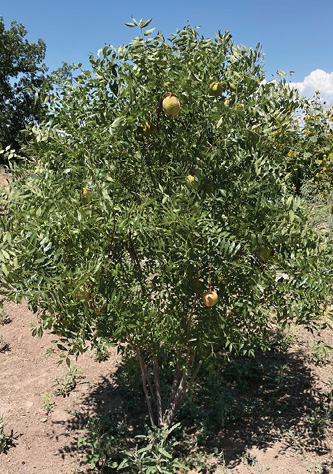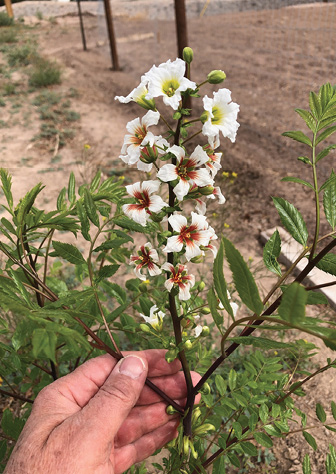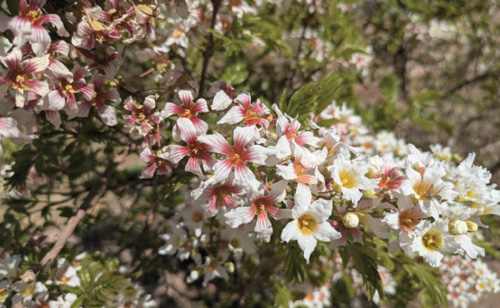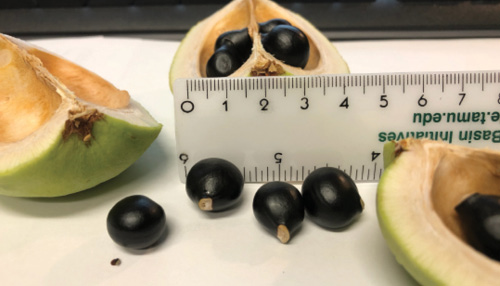Guide A-103
Jeff Anderson, Pilja Vitale, Govinda Sapkota, Efren Delgado, Omar Holguin, Elora Roberts
College of Agricultural, Consumer and Environmental Sciences, New Mexico State University
Author(s): Respectively, Agriculture and Horticulture Extension Agent, Doña Ana County Cooperative Extension Service; Extension Economist, Department of Extension Economics; Postdoctoral Researcher, Department of Family and Consumer Sciences; Professor and Department Head, Department of Family and Consumer Sciences; Professor for the Department of Plant and Environmental Sciences and Director, Center of Excellence in Sustainable Food and Agricultural Systems; Graduate Student, Department of Family and Consumer Sciences. All from New Mexico State University. (Print Friendly PDF)


Introduction
As drought conditions intensify across New Mexico, farmers are seeking alternative crops that demand less water than traditional crops. This is a critical need as water availability for agriculture continues to decline. According to USDA statistics,7 the area of irrigated farmland in New Mexico has steadily declined over the past few decades, from 0.85 million acres in 1997 to 0.55 million acres in 2022, due to ongoing water shortages.
In this publication, we introduce Yellowhorn (Xanthoceras sorbifolium), a promising drought-tolerant, high-income potential crop with a 14”–18” of annual water requirement.
Native to northern China, the Yellowhorn is a hardy, deciduous shrub or small tree deserving renewed attention in our region. The tree offers oil-rich, edible seeds, nectar-rich flowers for apiculture, and other plant materials with potential nutritional and medicinal value, in addition to its striking ornamental beauty (Figure 1).
This publication explores the potential of Yellowhorn for New Mexico agriculture, highlighting its adaptability, unique appearance, culinary and cosmetic uses, and its relevance as a resilient, water-smart crop for the future.
History and Botanical Significance
The genus name Xanthoceras has intriguing roots. It is believed to be derived from the Greek words “xanthos” (yellow) and “keras” (horn), likely referring to the yellowish, horn-shaped glands found between the flower petals. Regardless of interpretation, the name reflects the plant’s unique ornamental character.
Cultivation and Spread
Yellowhorn has a long history of cultivation dating back to the early 19th century. It was officially named by German botanist Alexander von Bunge in 1833. The tree was introduced from China to Russia in the 1820s, reached France in 1866, and eventually arrived in North America by the late 1800s.9
Initially valued for its ornamental qualities and hardiness, Yellowhorn is cultivated for its high oil content, drought tolerance, and pharmaceutical properties. Of particular interest is its seed oil, which contains 3.04% nervonic acid—a compound known for supporting cognitive brain function and being explored as a potential treatment for Alzheimer’s disease and other neurological conditions.6 Today, China actively cultivates Yellowhorn as a sustainable source of biofuel, thanks to its resilience in arid regions and high oil yield.12
Growth Characteristics
Yellowhorn trees typically grow to a height of 6 to 24 feet, a size well-suited for both small-scale and diversified farms. Their glossy dark green leaves, resembling those of Mountain Ash, have lighter-colored undersides that give the tree a soft shimmer in the wind.10 In early spring, before the leaves emerge, Yellowhorn produces striking clusters of white blossoms (coral red forms also exist), each adorned with greenish-yellow streaks and a blush of red at the base (Figure 2a). These eye-catching flowers attract pollinators and enhance the ornamental value of the trees.
Round to pear-shaped fruit is roughly the size of a tennis ball (Figure 1a). It starts green and matures to a yellow-tan hue. Each fruit capsule contains three to four internal chambers (locules), and within each chamber are up to 8-12 shiny, black seeds. When fully ripe, the fruit naturally splits open, revealing a spongy white interior and the round, purplish-black seeds (Figure 2b).

Figure 2a. Yellowhorn flowers.

Figure 2b. Seeds and capsules.
Edible Uses
Yellowhorn is a remarkably edible foodstuff. Nearly every part of the tree offers culinary potential.11 The leaves and blossoms can be used in a variety of creative ways. Yellowhorn flowers, with their delicate shape and subtle fragrance, can be added to fresh salads or steeped in floral teas. The leaves contain 14–18% protein, making them a surprisingly nutritious option for leaf tea or herbal infusions.
However, the true highlight of the Yellowhorn tree is its seeds. Often compared to macadamia nuts, Yellowhorn seeds have a rich, buttery, slightly nutty flavor. However, their texture is waxier due to the high oil content. They also have a slight bitterness easily removed by roasting or rinsing in warm water. The seeds can be roasted, pressed for oil, or eaten raw, making them versatile ingredients for both sweet and savory dishes.5,8
Whether for the nutritional, novelty, or market potential, the Yellowhorn’s edible parts offer a promising opportunity for farmers and food entrepreneurs exploring new crops in New Mexico.
Oil Yield, Applications, and Medicinal Potential
Yellowhorn offers remarkable potential for both culinary and industrial uses. It is currently being cultivated internationally for a variety of applications, including cooking oil, cosmetics, tea, traditional medicine, and biofuel production.2 The fruit capsules contain oil, while the seeds (nuts), alone yield between 40% and 72% oil, making Yellowhorn one of the highest oil-content tree crops in its class. Seed oil is rich in unsaturated fatty acids along with neuroprotective Nervonic Acid (+/-3.04%), useful for cognitive brain function, Alzheimer’s, and other neurological disorders.4
Beyond its visual appeal, Yellowhorn has potential medicinal uses with anti-tumor, anti-inflammatory, anti-bacterial, and antioxidant properties.3 Recent research highlights the compound xanthoceraside—a novel triterpenoid saponin extracted from Yellowhorn capsules—as having antitumor properties and potential therapeutic applications for Alzheimer’s disease.6,12 The high polyunsaturated fatty acids (PUFAs) content (38%) makes Yellowhorn oil beneficial in reducing inflammation and supporting immune function, much like the benefits of sesame and pecan oils.
Preliminary research from New Mexico State University (NMSU) indicates that Yellowhorn trees grown in New Mexico may exhibit more desirable characteristics compared to other regions, such as favorable adaptation to local conditions. Continued research will help confirm these findings and support future production recommendations for local growers.
Potential for waste valorization
Besides Yellowhorn’s use for oil production, the wastes: press cake, nutshell, and fruit capsules have the potential to be utilized as feed ingredients for ruminants, bioactive compounds extraction to produce food additive microcapsules, and raw material for biochar production.
Economic Potential for New Mexico
Yellowhorn presents a promising high-value crop opportunity for New Mexico farmers, especially those seeking alternatives to traditional, water-intensive crops. Its resilience, compact size, and low input requirements make it particularly well-suited for beginning farmers, small-scale operations, socially disadvantaged producers, and tribal communities across the state. Yellowhorn does not require large land, expensive machinery, or intensive labor. These characteristics make it accessible and manageable for diverse agricultural settings.
Currently, Yellowhorn seed oil is sold at approximately $79 per 500 milliliters, which equates to about $598 per gallon (Neuro Botanic, https://neurobotanic.com). Based on a planting density of 242 trees per acre, and assuming each tree yields one gallon of oil, a single acre could generate 242 gallons of oil, generating a potential gross income of $144,716 per acre. For reference, Maple River Farms in Owosso, Michigan, lists Yellowhorn oil at around $8.50 per ounce ($1,088/gallon) in the U.S. retail market, equating to $263,296.00 potential per acre based on current sales data (Maple River Farms, Owosso, Michigan, https://www.mapleriverfarms.com).
To support growers interested in this emerging crop, New Mexico State University (NMSU) is actively working to develop a standardized processing system—from nut to oil—that will help ensure product quality, streamline production, and improve market accessibility for Yellowhorn producers throughout the state.
Local Adaptation and Research in New Mexico
As of January 2025, approximately ten New Mexico farmers have established Yellowhorn orchards of one acre or more, while at least eight additional producers have established the crop on small scales. Interest in Yellowhorn continues to grow across the state as farmers explore drought-resilient, high-value alternatives to traditional crops. This guide represents the first resource provided through an American university intended to help farmers determine the feasibility of Xanthoceras sorbifolium ‘Yellowhorn’ production, and economic potential in the Southwestern United States.
The NMSU College of Agricultural, Consumer and Environmental Sciences (ACES), Family and Consumer Sciences Department has begun preliminary analyses of Yellowhorn oil to evaluate its nutritional and health-related components. Early findings indicate the oil possesses promising heart and nerve health benefits, particularly when the trees are grown in New Mexico’s arid climate, where stress conditions may enhance the quality of bioactive compounds.
Conclusion
Yellowhorn represents a high-potential specialty crop for New Mexico agriculture. Its drought tolerance, multifunctionality, and economic promise make it well-suited for the region’s evolving needs of the State. Ongoing research and Extension support aim of the crop to expand opportunities for producers and provide practical recommendations for successful adoption.
References
- Anderson, J. (2024). The Remarkable Yellowhorn Tree: A Botanical Marvel (Xanthoceras sorbifolium) [Fact Sheet]. Doña Ana County Cooperative Extension Service. https://donaanaextension.nmsu.edu/documents/yellowhorn-factsheetengl.pdf
- Cui, C., Fang, Y., Mu, Y., Yang, L., Zeng, L., Li, H., Wang, H., Zhou, L., Li, C., & Xie, Y. (2025). Xanthoceras Sorbifolium Bunge Oil: Extraction Methods, Purification of Functional Components, Health Benefits, and Applications in Production and Daily Life. Foods, 14, 1004. https://doi.org/10.3390/foods14061004
- Cui, W. J., Li, R. H., Chen, X. L., Xia, Z. M., Liu, S. F., Li, M., Chen, L., Tian, Y., Li, B., Zhang, G.J., Liu, S.C., & Wang, L. (2024). A review on triterpenoid and triterpenoid saponins from Xanthoceras sorbifolium Bung. Carbohydrate Research, 539, 109120. https://pubmed.ncbi.nlm.nih.gov/38669825/
- Huang Y., Yin Z., Guo J., Wang F., & Zhang J. (2019). Oil extraction and evaluation from yellowhorn using a microwave-assisted aqueous saline process. Molecules, 24, 2598. https://www.mdpi.com/1420-3049/24/14/2598
- Li J., Zu Y-G, Fu Y-J, Yang Y-Ch, Li S-M, Li Z-M, & Wink M. (2010). Optimization of microwave-assisted extraction of triterpene saponins from defatted residue of yellow horn (Xanthoceras sorbifolia Bunge) kernel and evaluation of its antioxidant activity. Innovation food science and emerging technologies, 11(4), 637-643. https://www.sciencedirect.com/science/article/abs/pii/S1466856410000676
- Li, Y., Xu, J., Xu, P., Song, S., Liu, P., Chi, T., Ji, X., Jin, G., Qiu, S., Hou, Y., Zheng, C., Wang, L., Meng, D., & Zou, L. (2016). Xanthoceras sorbifolia extracts ameliorate dendritic spine deficiency and cognitive decline via upregulation of BDNF expression in a rat model of Alzheimer’s disease. Neurosci Lett., 629, 208-214. https://www.sciencedirect.com/science/article/abs/pii/S0304394016304979
- United States Department of Agriculture, National Agricultural Statistics Service, Mountain Regional Field Office. (2022). New Mexico Agricultural Statistics: 2022 annual bulletin. https://www.nass.usda.gov/Statistics_by_State/New_Mexico/Publications/
- Venegas-Calerón, M., Ruíz-Méndez, M.V., Martínez-Force, E., Garcés, R., & Salas, J.J. (2017). Characterization of Xanthoceras sorbifolium Bunge seeds: Lipids, proteins and saponins content. Industrial Crops and Products, 109, 192-198. https://www.sciencedirect.com/science/article/abs/pii/S0926669017305332
- Xanthoceras sorbifolium. (2025). In Wikipedia. https://fr.wikipedia.org/wiki/Xanthoceras_sorbifolium
- Xiao, J., Sun, L., Pan, Y., Bai, X., Chen, G., Zhang, X., Chen, X., & Li, N. (2023). Multipurpose Research from a Native Woody Oil Plant Xanthoceras sorbifolia in China. Forests, 14(1) 86. https://doi.org/10.3390/f14010086
- Yu, H., Fan, S., Bi, Q., Wang, S., Hu, X., Chen, M., Wang, L. (2017). Seed morphology, oil content and fatty acid composition variability assessment in yellow horn (Xanthoceras sorbifolium Bunge) germplasm for optimum biodiesel production. Industrial Crops and Products, 97, 425 -430. http://caf.irtree.com/articles/article_detail.aspx?id=43185e3b2c2b46b588f4cdfb9235bba9
- Zang, E., Qiu, B., Chen, N., Li, C., Liu, Q., Zhang, M., Liu, Y., & Li, M. (2021). Xanthoceras sorbifolium Bunge: A Review on Botany, Phytochemistry, Pharmacology, and Applications. Front Pharmacol. https://pubmed.ncbi.nlm.nih.gov/34526898/

To find more resources for your business, home, or family, visit the College of Agricultural, Consumer and Environmental Sciences on the World Wide Web at pubs.nmsu.edu.
Contents of publications may be freely reproduced, with an appropriate citation, for educational purposes. All other rights reserved. For permission to use publications for other purposes, contact pubs@nmsu.edu or the authors listed on the publication.
New Mexico State University is an equal opportunity employer and educator. NMSU and the U.S. Department of Agriculture cooperating.
July 2025 Las Cruces, NM


